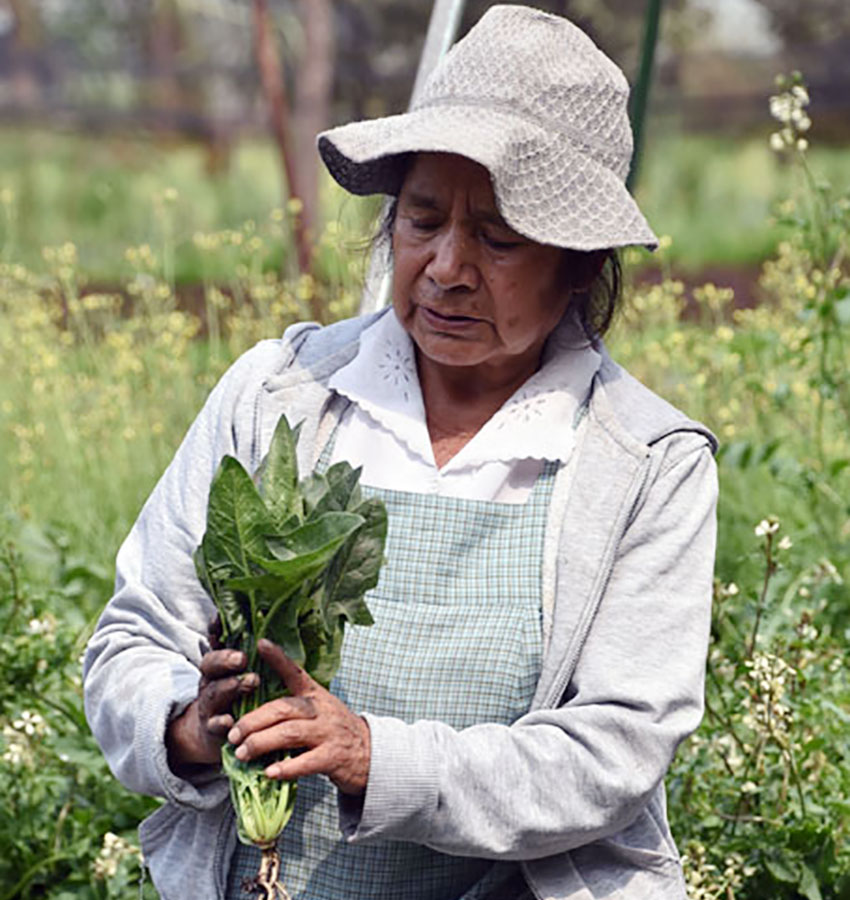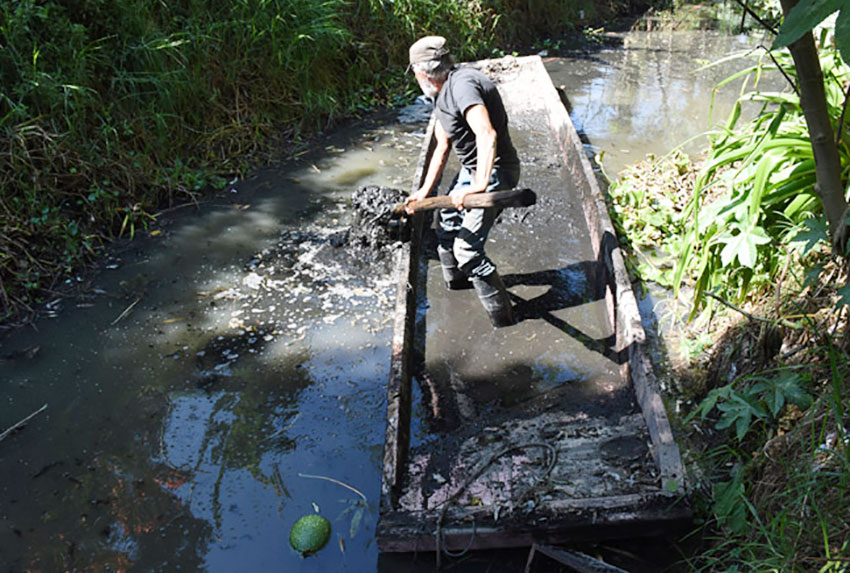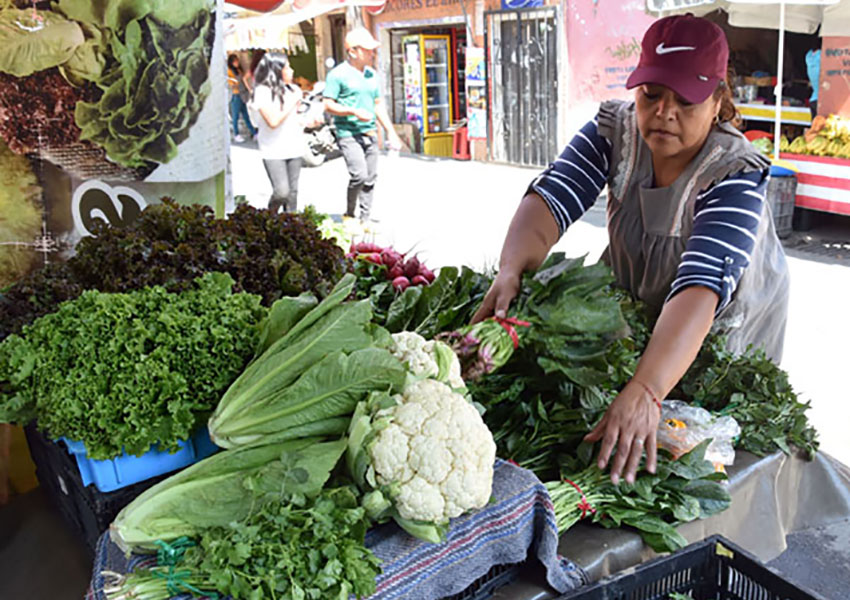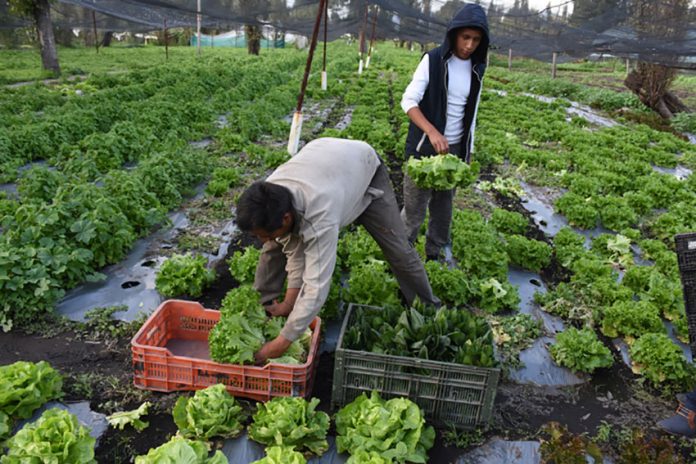Walking into the chinampería, San Gregorio Atlapulco’s ancient agricultural area, is like walking into another world.
One minute you’re in the city with its traffic and noise — San Gregorio is part of Xochimilco, a borough of Mexico City — and then, crossing its main street, you walk a short distance and you’re in the middle of farmland. Rows of lettuce, radishes, spinach, cilantro, parsley and other vegetables and herbs seem to stretch on forever.
The chinampería consists of rectangular man-made islands, called chinampas, built in the shallow lakes of the Mexico basin. The area is often referred to as Mexico’s floating gardens but the chinampas don’t float, they’re firmly anchored to the lake’s bottom. They’re constructed by first sinking branches from the huejote tree (a species of willow that’s considered sacred) into the lake bottom, forming rectangles that are typically 10 x 100 feet, which are then filled in with mud and vegetation.
There’s archaeological evidence that the earliest chinampas were built between 5,000 and 6,000 years ago. The ones that are still farmed in San Gregorio are probably between 1,200 and 2,000 years old and were built by the Xochimilcas (who are also known as the Aztecs).
Canals between the chinampas allow for easy access by canoes and in Xochimilco, colorful boats known as trajineras take tourists for rides. “People know Xochimilco and the trajineras,” said Paola Casas González, one of a handful of women working in the chinampería, “but they don’t know this pueblo or these chinampas that produce tonnes of food for the country. There are people living in the city who only know the trajineras.”

Chinamperos, as people who farm the chinampería are called, use farming techniques that are as old as the chinampas themselves.
Martín Venagas Paéz stands in his canoe, using a long pole with a net at the end which he uses to dredge up mud from the bottom of a canal, dumping it into the boat’s bottom. He hauls the mud in buckets to a shallow rectangle that’s been dug in the ground and pours it in. The mud is allowed to dry for a day or two and then cut into tiny squares called chapines, into which seeds will be placed. Once the seeds sprout and the plants are big enough, they’ll be transferred to a chinampa. The land here is so fertile that it’s possible to have four or even five harvests a year.
The land that Juan Serralde and his brother Erick farm has been in their family for generations. “My great-grandfather, grandfather, and father all planted this land,” Juan said. They, like all chinamperos, work six or sometimes seven days a week. “We work every day, every day,” said Venagas Paéz, whose land is a short distance from Serralde’s. “Here there is no rest. I work, eight, 10, 12 hours a day.” He figures he earns about 150 pesos (about US $6) a day.
Given the difficult work and minimal earnings, it comes as no surprise that few young people want to work in the chinampería. Daniel López, like the Serraldes, works land his great-grandfather once did but is unsure if it will stay in his family. “Life here is hard,” he said. “My son does not want to work as a chinampero; he is studying computer technology. I will pass the land to my daughters and if they do not want it, they will sell it.”
Although the chinampería is still amazingly productive, chinamperos and their supporters are very concerned about its continued survival. Several issues are threatening it; first among them is Mexico City’s chaotic and unchecked growth.
According to Miguel Ángel Elizado, an attorney who has represented chinamperos for 18 years, the chinampería originally covered around 8,900 hectares. “Now there are only about 3,000 hectares,” he said. One day I drove with him through Xochimilco and he pointed out many streets that had once been canals.

As Mexico City has continued to expand, taking land that had once been used to grow food, it has also taken much of the chinampería’s water to slake its residents’ thirst. Although water has been extracted from the chinampería for literally centuries, a canal built in 1905 to carry water from springs and rivers that fed the chinampería into the city center had a devastating effect, one that continues to this day.
“There is little water now,” said Erick Serralde. “In the past, the water was clean; we could swim, fish. This was 30 years ago. Now, the water is about 1.5 meters deep. Before it was five or six meters.” He pointed to a nearby canal. “This is a dead canal. Thirty years ago, it was young. We could use canals to deliver our produce. Now, we have to carry it on our backs to the loading dock.”
Although it’s illegal to build houses in the chinampería, people still do it. This mostly goes unpunished and has resulted in another problem: huge amounts of agua negra, untreated wastewater, being dumped into canals. The smell rising from them is almost overwhelming.
And if those problems weren’t enough to threaten the chinampería’s survival, chinamperos are now threatened by the coronavirus.
Many sell their produce in the Central de Abasto, a huge market in Mexico City that’s become a hot bed for the virus. A number of San Gregorio’s chinamperos and other people working in the market have been infected with Covid-19. When I asked Erick Serralde if he knew exactly how many in San Gregorio were sick, all he could say was “Many.”
The virus has also taken an economic toll on chinamperos.

Margarita Vega Honorato has been working in the chinampería all her life. She pointed to a chinampa filled with row after row of lettuce that was going to seed and would have to be plowed under soon. Most of her produce was sold to restaurants in Mexico City, which have been closed for weeks.
“Before [the virus] we sold everything,” she said. “Now, we sell almost nothing.” She walks a short distance and points to another parcel of land. “We planted all this yesterday. We will see if we can sell that but, really, who knows?”
Leonel Rufino Vega, her husband, stepped forward and asked angrily, “Who will buy it? Who will buy it now?”
San Gregorio’s market is still open and although there are fewer people, stalls are still crammed with produce that was recently harvested in the chinampería. “This pueblo is dedicated to this, to selling vegetables,” said Carmen Cruz Sánchez, a chinampera. “This is how we live. Who knows how long we will survive?”
She said that she’s selling about half what she used to. “My family is surviving by buying only the basics,” she continued, “beans, rice, eggs, rarely meat.”
Mexico is now deep into phase three of the pandemic. Cases and deaths continue to rise. There’s no indication that it will end soon and it’s not clear what the government will do. “If they prohibit everything, we will still have vegetables here, we will have rice,” said Coat Rufino, Margarita’s son. “I do not know if we can sell what we have but we will keep working.”
Joseph Sorrentino is a frequent contributor to Mexico News Daily and lives in San Gregorio.
